|
IRAS 16342-3814 (OH 344.1 +5.8,
OH 344.07 +5.84) -- a water
fountain star.
Mm and Radio Observations
-
OH 1612, 1665, 1667 MHz masers showed large
velocity separations dV in IRAS 16342-3814. dV
increases from 71 km/s for 1665 MHz to 83 km/s for 1667 MHz to 116 km/s
for 1612 MHz masers. H2O masers showed even higher
dV = 234.8 km/s. It could be a water fountain star that show high velocity bipolar outflow.
(from Likkel et al., 1988ApJ...329..914L)
(figure: left -- H2O
masers; right -- OH masers in IRAS 16342-3814.)
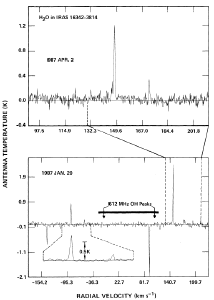 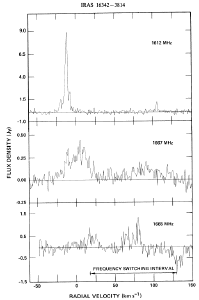
-
OH maser and polarization measurements were reported to two IRAS sources IRAS 16342-3814 and IRAS 15405-4945
(OH 329.14+3.92). OH 1665, 1667 and 1612 MHz masers in IRAS 15405-4945 showed increasing velocity ranges sequentially
(100, 175, >175 km/s respectively). A circular polarization of 25% was found in its 1665 MHz maser spots. The maser velocity ranges of IRAS 16342-3814 showed
similar trends (80, 140, 140 km/s for 1665, 1667 and 1612 MHz masers) and higher
circular polarization was found to be 25-50%, 25% and 25-50% respectively. (from Te Lintel Hekkert et al.,
1988A&A...202L..19T)
(figure: left -- OH maser profiles; right -- corresponding
circular polarization (Left pol - Right pol).)
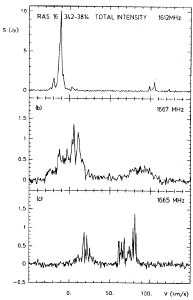 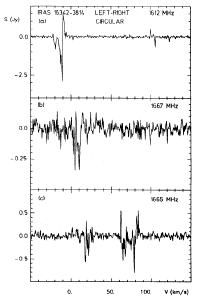
-
Monitoring of 1.3cm H2O maser spectra of 3 water fountain stars IRAS 16342-3814, IRAS 19134+2131 and
W 43A revealed variations as short as one
month. No maser feature velocity shift was found to be > 1km/s. The varying spectral features seemed to be
stable at several discontinuous fixed velocities for at least a few
years. The apparent symmetry in the H2O spectra allows determination of
the central velocities and suggests bipolar geometry. H2O maser velocity spreads are
dV = 130, 132, 180 km/s (disagree to the spectral
plots!?) and central velocities are Vlsr = +43.2+-0.9, -67.4+-0.4
and +33.6+-1.0 km/s for the 3 stars respectively.
(from Likkel et al.,1992A&A...256..581L)
(figure: left 3 col -- variation of
red half of H2O masers; right 3 col -- variation of blue half of H2O masers.)
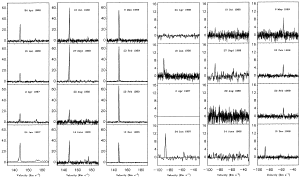
-
They didn't detect the SiO J=1-0, v=1,2 masers with rms of 2.0 and 0.8 Jy respectively.
(from Nyman et al., 1998A&AS..127..185N)
-
The central star of IRAS 16342-3814 could be a young post-AGB star (because it is non-variable,
and has very red IRAS/LRS spectrum). HST observation with F814W and F555W
filters revealed bipolar scattering lobes. VLA
mapping of OH 1612, 1665 and 1667 MHz masers
uncovered a bipolar distribution aligned well
with the HST bipolar lobes. They found a inclination angle of ~40 deg. The OH masers also showed an increase of
l.o.s. velocity with distance to the central star, indicating increase
of jet velocity with radius, in accord with a wind
interaction model. A distance of ~2 kpc
was estimated by assuming a luminosity of ~6000 Lsun. A coarse mass loss
rate of Mlr ~ 10^-4 * (Vexp/15km/s) [Msun/yr]
was given (assuming gas-to-dust mass ratio of 200). CO,1-0 and 2-1 observations using SEST gave non-detection,
with 5 sigma upper limits of TA* = 0.014 and 0.05 K respectively. The post-AGB nature of the star is critically examined. (from Sahai et al., 1999ApJ...514L.115S)
(figures: left -- HST map, middle -- overlayed OH
masers; right -- increase of maser velocity with radius)
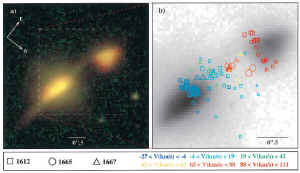 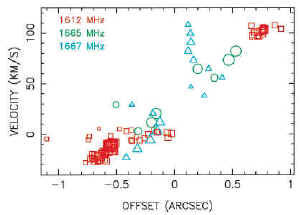
-
They compiled 35 post-AGB stars with high outflow velocity (dV>50 km/s).
Most of them have OH masers, but several RSGs are also included due to their criteria.
They then mapped OH masers of 10 sources with interferometers
(VLA, ATCA, PTI, MERLIN). In IRAS 16342-3814,
the OH 1667 masers are distributed around a central torus and in the root part of optical bipolar outflow
wall. The forbidden stellar velocity of IRAS 16342-3814 argues that it belongs to a
lower mass, old population. OH masers appear in two groups, separated by an invisible
edge-on disk/torus of ~0.35"
thick. Maser spots aligned linearly, extending over radius of
~0.8". The brightest OH maser spots appear at the strongest point in the optical lobe,
magnifying the continuum emission. They predicted a distance of 700 pc on the basis of IR radiative transfer modeling.
They proposed that the OH masers may arise from the swept-up
shell in the interacting wind model and OH molecules
may be produced H2O that is photo-dissociated by radiation from the central star.
(Could it be due to atomic gas in the fast wind that induces chemistry on the bubble
wall?) (from Zijlstra et al., 2001MNRAS.322..280Z)
(figure: left -- spatial
distribution of OH maser spots; middle -- spatio-velocity relation; right -- overlay of OH
masers on HST V filter (F555) image of the optical lobes.)
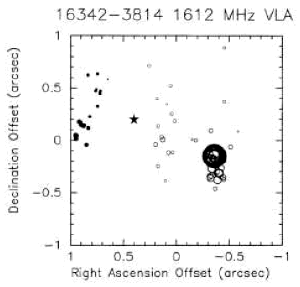 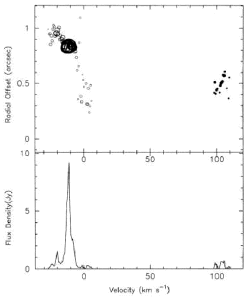 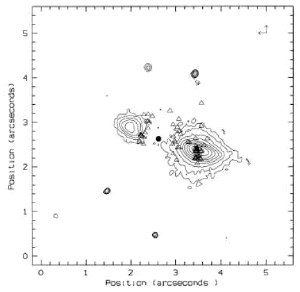
-
VLBA detected H2O
masers in IRAS 16342-3814. The maser
spots are separated in bipolar regions spreaded >2"
(4000AU * D/2kpc). The highest velocity spots (in a very small region) align
in quasi-linear strings, indicating of planar shock
interface. The extreme velocities of H2O maser are 180 km/s and
-68 km/s, so Vexp,l.o.s. = 124 km/s. (from
Morris et al., 2003RMxAC..15...20M)
(figure: H2O maser map. Plus signs mark
the center of the optical lobes.)
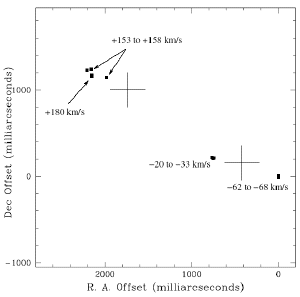
-
VLBA observations showed proper motion of H2O maser spots near the blue
lobe of IRAS 16342-3814. The maser spots align
in a curve that delineates the shock front. (from Claussen et al., 2004ASPC..313..331C)
(figure: proper motion of H2O maser
spots near the blue lobe: circles -- Feb. 2002; triangles -- Mar. 2002; squares -- Apr. 2002; hexagons -- May 2002.)
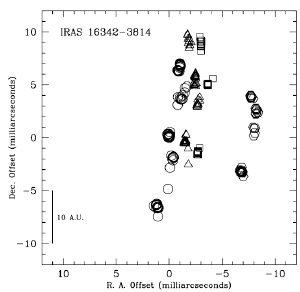
-
They didn't detect SiO J=1-0, v=1,2 masers with rms of 66mK and 72 mK respectively.
(from Deguchi et al., 2004PASJ...56..765D)
-
They detected OH 1612 MHz maser with Vexp = 66 km/s, 1667 MHz maser with
Vexp = 58.5 km/s at epoch of JD = 2452758. IRAS 16342 was found to show extremely high polarization degree
of |mC| > 70% and |mL| > 14% for several blue shifted 1612 MHz maser spots (among 7 PPNs
that show similarly large polarization). (from Szymczak et al., 2004A&A...423..209S)
(fig. left -- OH 1612 MHz maser polarization; right -- OH 1667 MHz maser
polarization)
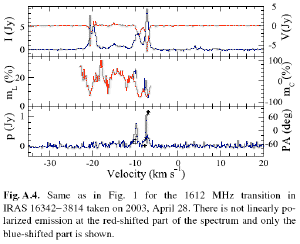 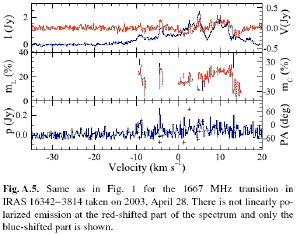
-
They detected CO and 13CO 1-0 lines toward IRAS 16342. This is the first detection of thermal molecular line in a water
fountain star. The extremely low CO/13CO
line intensity ratio of ~1.7 possibly indicates
that the star is a massive AGB star experienced Hot bottom Burning. However,
opacity effects in the CO lines are not clear. The broad 12CO 1-0 line (with
Vexp=46 km/s) should come from
the wall of the accelerated warmed-up bipolar bubble. The estimated CO mass loss rate is about one order of magnitude lower than
that estimated from IR and OH maser data, which indicates that the
star is embedded in very thick and cold cocoon. (from He et al., 2008A&A...488L..21H)
- VLBA mapping of water masers in the water fountain star, IRAS 16342-3814 revealed movement of bow shock fronts at the both sides of the bipolar jets. The spatial velocity of the masers were found to be as high as +-180 km/s, which constrains a very young dynamical age of ~ 100yr. (from Claussen, Sahai & Morris, 2009ApJ...691..219C)
(figs. upper row -- blue, red H2O maser spectral, maser spots, time evolution of the separation of two red maser spot clusters;
lower row -- propermotion of maser spots around -66, 153.3, 178.7 and -27 km/s, left to right.
)
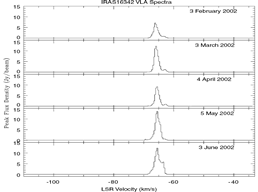 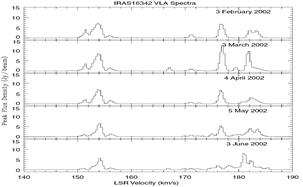 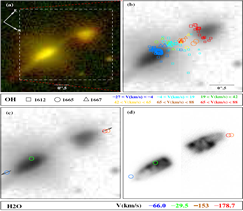 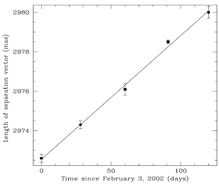
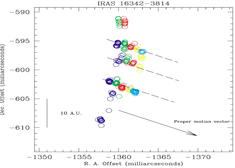 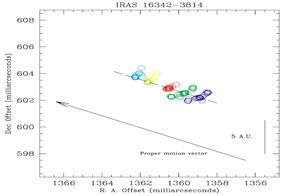 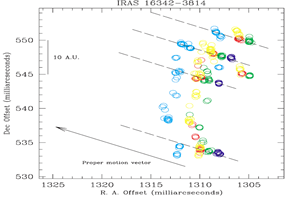 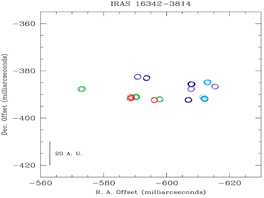
|
Infrared/Optical Observations (back to top)
-
The 2-200um ISO spectrum and 3.8-20um ISAAC and TIMMI2 images were presented for
IRAS 16342.
Amorphous silicate absorption is found at 10 and 20um and it is the only OH/IR source that
show
crystalline silicate absorption features up
to
45um. The estimated mass loss rate can be as
high as
10^-3 Msun/yr. Images showed bipolar structure
at 3.8um that gradually shifts to spherical shape (diameter of 6")
towards 20um, which demonstrates a transition from spherical morphology to bipolar morphology
in the histroy of this star. The dust grain sizes were estimated to be about
1.3 and 0.09um in the torus and bipolar nebulae respectively. The silicate
absorption indicate that the CSE is very
cold and optically thick. Therefore, the lack
of NIR emission from this star may not be due to the lack of hot dust, but
due to very large opacity. (from Dijkstra et al., 2003A&A...399.1037D)
(fig. left -- ISO spectrum compared with other objects; middle -- IR line features;
right -- IR
maps)
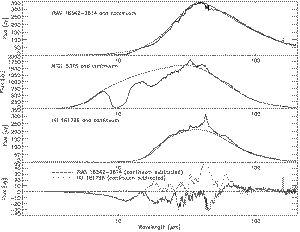 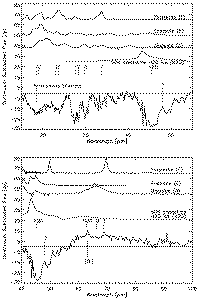 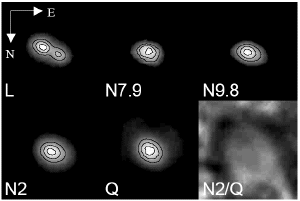
-
They found tentatively detected 53.3um OH absorption line in the ISO spectrum of
IRAS 16342. (from He & Chen, 2004NewA....9..545H)
-
They didn't detect the 34.6um OH absorption
line in ISO spectra of IRAS 16342-3814. (from He et al., 2005A&A...434..201H)
-
Keck AO maps of IRAS 16342-3814 in Kp and Lp
band revealed corkscrew pattern on the dense wall of
the bipolar lobes, which strongly suggests well
collimated precessing jets with diameter <
100 AU and precession period < 50 yr.
H band image looks like optical one and Ms band image has worse S/N ratio.
Av =0.77 was used to correct colors. IR radiative transfer modeling showed
that the IR colors in the lobes can be reproduced only by warm dust emission
(Td=600-700 K) and therefore, a dense warm dust cocoon
is there around the star. These hot dust shouldn't be an accretion disk around the star,
but be a cocoon with two holes penetrated by the bipolar jets. (from Sahai et al., 2005ApJ...622L..53S)
(figure: left -- Kp and Lp band
images of the bipolar lobes; right -- a) Lp maps with sketch of corkscrew patterns; b) psudo-color made from
Kp, Lp and HST images.)
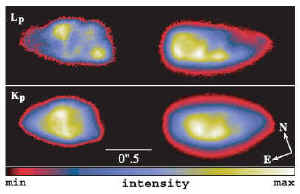 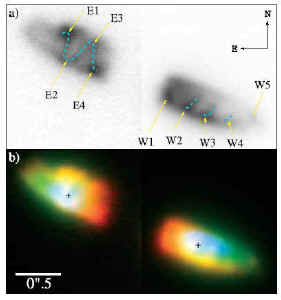
-
The 34.6 um OH absorption was not found in ISO spectrum but the 53.3um tentatively was.
The estimated OH maser radiative pumping rate is
(1.10-1.62)x10^-3, in the intermediate range between typical stellar OH 1612MHz masers and typical
interstellar masers, which indicates that the favorable condition for radiative pumping of the OH 1612 MHz masers is fading away.
(from He, 2005NewA...10..283H)
-
Spitzer MIPS imaging at 70 and 160um showed possible
evidence of extended dust shell with radius of 400" (~4 pc at a source distance of 2 kpc). The homogeneous
dust temperature of about 26 K over the radius was argued to be maintained by interstellar
radiation field heating. Their 70um and 160um maps were modeled by two components:
a central CSE and an outer shell
of 1 pc thick. They estimated a gas mass loss rate of 3x10^-4 Msun/yr for the shell and 3x10^-5 Msun/yr for the central CSE assuming a gas-to-dust mass ratio of 200. But this mass rate is sensitive to the dust
temperature as ~T^-7.6 at 70um. (from Do et al.,
2007AJ....134.1419D)
- They mapped IRAS 16342 using the MIR instrument VISIR on VLT in both imaging and spectroscopic modes from 8um to 13um. They found that the dark waist is still cold and dark in the MIR wavelength range. Two intensity peaks are separated by 0.92 arcsec, with PA = 66 deg (East of North). Thus they proposed that the dust shell is still nearly spherical and only the precessing jets are sculpturing the bipolar lobes. The dust opacity found in the approaching lobe argues against the disk or torus explanations. (from Verhoelst et al., 2009arXiv0906.0901V)
(figs. left -- the 11.85um image with a spatial resolution of 0.127 arcsec; right -- the model to interpret the dark waist and the dust opacity in the blue lobe.)
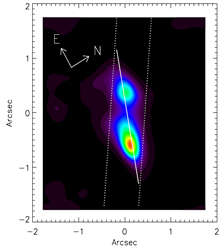 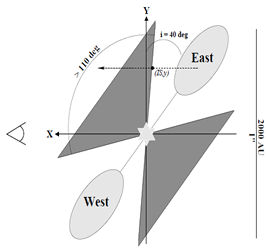
(back to top)
|
|
![]()